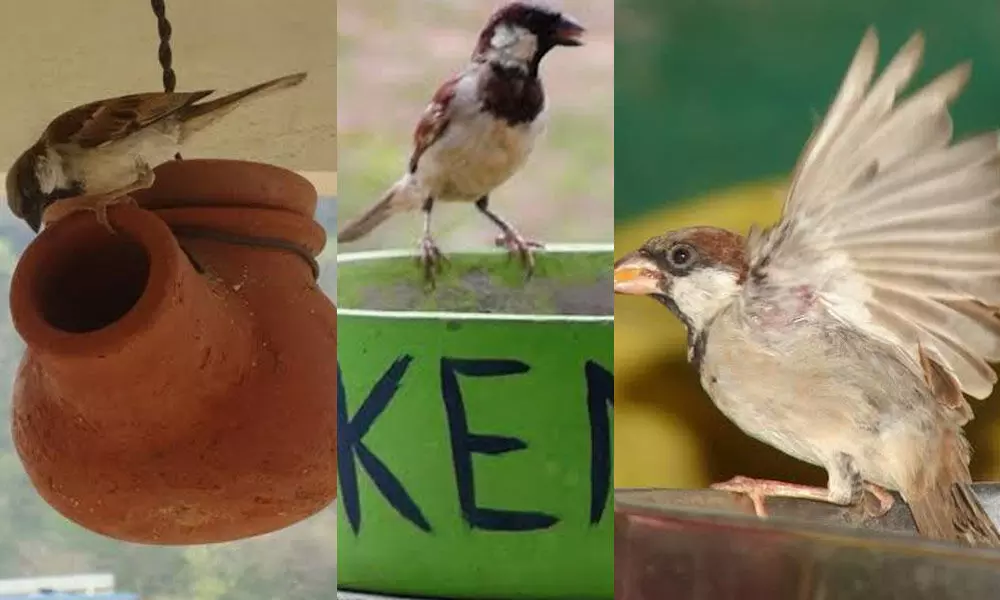Live
- BRS rallies support for Lagacharla ‘victims’
- COP29: Scientists, artists, faith leaders call for greater commitment to delivery of climate finance
- Woman donates liver to husband, saves life
- Mechanic Rocky Review: Thrilling Action Film with Twists and Great Performances
- Ponguleti Sudhakar Reddy rubbishes Rahul Gandhi's claims on Modi and Adani
- ‘We can’t take things for granted’: Jayasuriya on balancing formats and Sri Lanka’s path to WTC final
- Prakash Ambedkar ready to 'power' the winner in Maha polls - Mahayuti or MVA
- BJP plans campaign against Cong govt
- Be lifelines to public & render best, cops told
- Siri 2.0: Apple's Advanced AI Assistant to Be Released in 2026
Just In
Small steps to save chirpy sparrows


Small steps to save chirpy sparrows
Decades back, the tiny chirpy house sparrows used to frequent the windowsill, balcony, backyard and terrace.
Decades back, the tiny chirpy house sparrows used to frequent the windowsill, balcony, backyard and terrace.
Not any longer as they find urban settings 'out of place' and quite unwelcoming. Global warming increase in concrete jungles, unfriendly environs, radiation emanating from the mobile towers and lack of feed sum up the reasons for an apparent decline in the sparrow population.
Environmental activists, NGO representatives and an army of volunteers vouch for nature-friendly interventions to invite the chirpy creatures back to the house and open spaces.
On the occasion of the 'World Sparrow Day' observed on March 20, they say that it does not take much effort to show a little concern for the sparrows and revive the scenario. Just a bowl of water, a feeder brimming with food grains, a few bird-friendly plants at right corners and artificial nests in open spaces are some of the interventions they advocate to draw the house sparrows and contribute to conserving the urban ecosystem in whatever little manner possible.
Expressing concern over declining population of sparrows, environmentalist and CEO of SagaraVikasa, a women empowerment society, K Srinivas Kumar, says, "Compared to other urban settings in Visakhapatnam, the presence of house sparrows is felt in parts of Bheemunipatnam and Tagarapuvalasa. But lack of nesting sites is another serious concern which needs to be looked into. Tying up with a few organisations, artificial nests were placed in some of the open spaces to attract sparrows. Little steps will certainly lead to an obvious improvement." For the past five years, Srinivas Kumar has been building awareness among communities on sparrow conservation and encouraging people to put up nests at home, balcony, terrace and garden spaces.
Initiating a school garden, encouraging students to collect kitchen waste and involving them in growing green leafy vegetables along with a host of other veggies, Principal of GVMC High School, Rayapalem, Jayanthi Radha Kumari has been educating the students on sparrow conservation for the past couple of years. "As a part of the drive, we organise workshops on making artificial nests and feeders on the campus. In the process, children not only contribute to the sparrow conservation but also to the ecosystem," explains the Principal.
NGOs are playing a bigger role in saving sparrows, involving communities to take the lead. 'Green Climate', a non-government organisation in Visakhapatnam, has been working for birds over a span of 14 years. Visiting educational institutions, delivering lectures and organising workshops to design cost-effective bird feeders and artificial nests, the NGO aims at bringing a change in the communities. "Simple acts work wonders for the birds. Every small attempt we consider towards this direction will pave way for a larger conservation movement and that is what we focus on. When children get sensitised, they take the message forward as young eco-warriors and spread the word," opines JV Ratnam, secretary of Green Climate.
Ken Foundation Society, another Vizag-based non-profit organisation, distributes tinted concrete water bowls to save stray animals and birds from getting dehydrated during hot summer months. The NGO has been following the water bowl distribution activity for more than nine years.
Concerned about the declining population of sparrows, bird lovers, environmental activists and NGO representatives advocate simple conservation measures and share best practices through social media platforms to save chirpy sparrows before they disappear from the concrete jungle for good.

© 2024 Hyderabad Media House Limited/The Hans India. All rights reserved. Powered by hocalwire.com






